CBSE Class 9 Maths Notes Chapter 4 Lines and Angles Pdf free download is part of Class 9 Maths Notes for Quick Revision. Here we have given NCERT Class 9 Maths Notes Chapter 4 Lines and Angles.
CBSE Class 9 Maths Notes Chapter 4 Lines and Angles
1. Basic Terms and Definitions
(i) Line segment: A part of a line with two endpoints is called a line segment.
![]()
Line segment AB is denoted by (bar { AB }).
(ii) Ray: A part of a line with one endpoint is called a ray.
![]()
The ray AB is denoted by (xrightarrow { AB }).
(iii) Collinear points and non-collinear points: If three or more than three points he on the same line, then they are called collinear points, otherwise, they are non-collinear points.
![]()
P, Q and R are collinear points.

A, B and C are non-collinear points.
2. Angle: An angle is formed when two rays originate from the same endpoint.

Angle ABC is denoted by ∠ABC
The rays ((xrightarrow { BA }) and (xrightarrow { BC })) making an angle are called the arms of ∠ABC.
The end point (B) is called the vertex of ∠ABC.
3. Types of Angles: There are different types of angles such as acute angle, right angle, obtuse angle, straight angle and reflex angle.
(i) Acute angle: An acute angle is an angle which is less than 90°.
Acute angle : 0° < x < 90°.
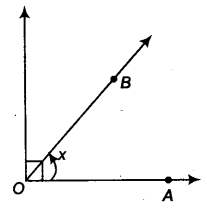
(ii) Right angle: A right angle is an angle which is equal to 90°.
Right angle : y = 90°
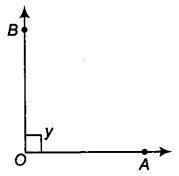
(iii) Obtuse angle: An obtuse angle is an angle which is more than 90° and less than 180°.
Obtuse angle : 90° < z < 180°

(iv) Straight angle: A straight angle is an angle which is equal to 180°.

Straight angle : s = 180°
(v) Reflex angle: A reflex angle is an angle, which is more than 180° and less than 360°.
Reflex angle : 180° < t < 360°
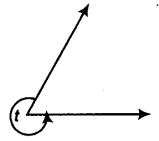
4. Complementary Angles: Two angles whose sum is 90° are called complementary angles.
5. Supplementary Angles: Two angles whose sum is 180° are called supplementary angles.
6. Adjacent Angles: Two angles are adjacent if they have a common vertex, a common arm and their non-common arms are on different sides of the common arm.
∠ABD and ∠DBC are the adjacent angles. Ray BD is their common arm and point B is their common vertex. Ray BA and ray BC are non-common arms.
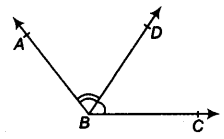
Note: ∠ABC = ∠ABD + ∠DBC
7. Vertically Opposite Angles: The vertically opposite angles formed when two lines intersect each other at a point.
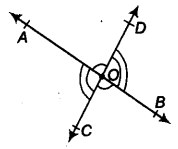
Two lines ABand CD intersect each other at point O, then, there are two pairs of vertically opposite angles.
One pair is ∠AOD and ∠BOC and another pair is ∠AOC and ∠BOD.
8. Intersecting Lines and Non-intersecting Lines
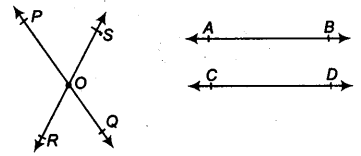
Lines PQ and RS are intersecting lines because they are intersecting each other at O.
Lines AB and CD are non-intersecting (parallel) lines.
Note: The lengths of the common perpendicular at different points on these parallel lines is the same. This equal length is called the distance between two parallel lines.
9. Pairs of Angles
Linear Pair of Angles: When the sum of two adjacent angles is 180°, then they are called a linear pair of angles.
(i) If a ray stands on a line, then the sum of two adjacent angles so formed is 180°.
(ii) If the sum of two adjacent angles is 180°, then a ray stands on a line (that is the non-common arms form a line).
∠AOC + ∠BOC = 180°
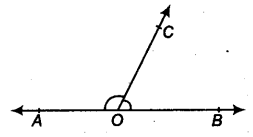
Property: If two lines intersect each other, then the vertically opposite angles are equal.
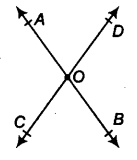
∠AOD = ∠BOC
∠COA = ∠DOB
10. Parallel Lines and a Transversal: A line which intersects two or more lines at distinct points is called a transversal.

Here, line l is a transversal of the lines m and n, respectively.
Line l intersects m and n at P and Q respectively, then four angles are formed at each of the points P and Q namely
∠1, ∠2, ∠3,…, ∠8
∠1, ∠2, ∠7 and ∠8 are called exterior angles.
∠3, ∠4, ∠5 and ∠6 are called interior angles.
We classify these eight angles in the following groups
(i) Corresponding angles.
- ∠1 and ∠5
- ∠2 and ∠6
- ∠4 and ∠8
- ∠3 and ∠7
(ii) Alternate interior angles
- ∠4 and ∠6
- ∠3 and ∠5
(iii) Alternate exterior angles
- ∠1 and ∠7
- ∠2 and ∠8
(iv) Interior angles on the same side of the transversal
- ∠4 and ∠5
- ∠3 and ∠6
Note: Interior angles on the same side of the transversal are also referred to as consecutive interior angles or allied angles or co-interior angles.
11. Relation Between the Angles when Line m is Parallel to Line n
(i) If a transversal intersects two parallel lines, then each pair of corresponding angles is equal.

i.e., ∠1 = ∠5, ∠2 = ∠6
and ∠4 = ∠8, ∠3 = ∠7
(ii) If a transversal intersects two lines such that a pair of corresponding angles is equal, then the two lines are parallel to each other.
(iii) If a transversal intersects two parallel lines, then each pair of alternate interior angles is equal.
i.e., ∠4 = ∠6
and ∠3 = ∠5
(iv) If a transversal intersects two lines such that a pair of alternate interior angles is equal, then the two lines are parallel.
(v) If a transversal intersects two parallel lines, then each pair of interior angles on the same side of the transversal is supplementary.
i.e., ∠4 + ∠5 = 180°
and ∠3 + ∠6 = 180°
(vi) If a transversal intersects two lines such that a pair of interior angles on the same side of the transversal is supplementary, then the two lines are parallel.
12. Lines Parallel to the Same Line: If two lines are parallel to the same line, will they be parallel to each other.
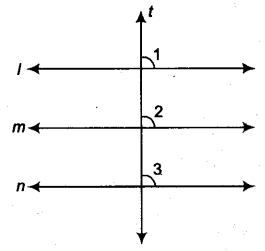
Here, line m parallel to line l and line n parallel to line l.
Hence, line m parallel to line n.
13. Angles Sum Property of a Triangle
(i) The sum of the angles of the triangle is 180°
∠1 + ∠2 + ∠3 = 180°.
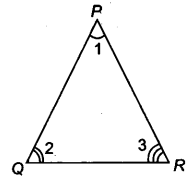
(ii) If a side of a triangle is produced, then the exterior angle, so formed is equal to the sum of the two interior opposite angles.
∠4 = ∠1 + ∠2
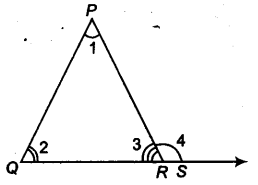
Note: An exterior angle of a triangle is greater than either of its interior opposite angles.
NCERT Notes for Class 9 Maths
- Chapter 1 Number Systems Class 9 Notes
- Chapter 2 Polynomials Class 9 Notes
- Chapter 3 Introduction to Euclid’s Geometry Class 9 Notes
- Chapter 4 Lines and Angles Class 9 Notes
- Chapter 5 Triangles Class 9 Notes
- Chapter 6 Coordinate Geometry Class 9 Notes
- Chapter 7 Heron’s Formula Class 9 Notes
- Chapter 8 Linear Equations in Two Variables Class 9 Notes
- Chapter 9 Quadrilaterals Class 9 Notes
- Chapter 10 Areas of Parallelograms and Triangles Class 9 Notes
- Chapter 11 Circles Class 9 Notes
- Chapter 12 Constructions Class 9 Notes
- Chapter 13 Surface Areas and Volumes Class 9 Notes
- Chapter 14 Statistics Class 9 Notes
- Chapter 15 Probability Class 9 Notes
We hope the given CBSE Class 9 Maths Notes Chapter 4 Lines and Angles Pdf free download will help you. If you have any query regarding NCERT Class 9 Maths Notes Chapter 4 Lines and Angles, drop a comment below and we will get back to you at the earliest.
<!–
–>